In this post, we will provide a list of different things you can see and experience at Piazza Navona, as well as a brief history and tips to plan your visit.
Overview
What was once the open space of a stadium has since been transformed into a public square, which is today a haunt for tourists and locals alike.
Built in 1 AD, the Stadium of Domitian was once known as a “Circus Agonalis,” or a competition arena where various athletic contests were performed.
It was Rome’s first permanent venue for competitive athletics.
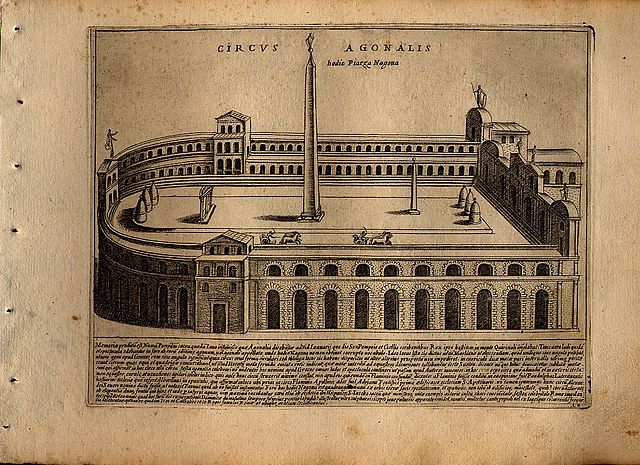
The stadium was almost exclusively used for feats of athleticism such as foot races.
But, there was a short time during 217 AD when it was actually used for gladiatorial combat.
Unfortunately, the stadium would eventually fall into disuse after the economic and political predicaments of the post-imperial era.
Eventually, the arcades served as housing for the poor, and the arena itself became a common meeting place.
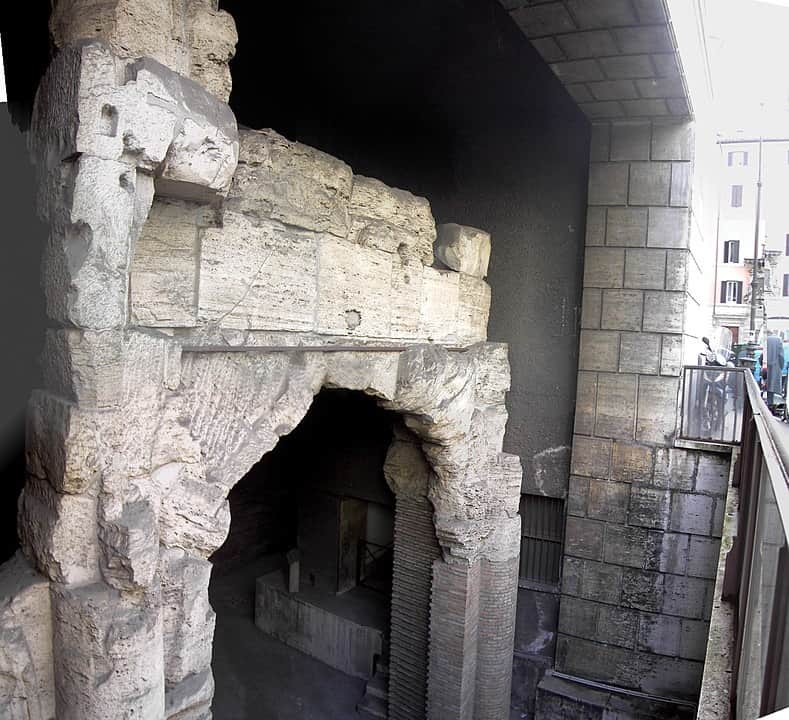
Over time, it was given the name of in navone (big ship), which would ultimately become shortened to navona after a while.
In the latter years of the 15th century, the stadium was finally defined as a public space.
At this point, several examples of baroque architecture and artwork were added, including three notable fountains: Fontana dei Quattro Fiumi, Fontana del Moro, and Fontana del Nettuno.
Although it served as the city market for hundreds of years, this market would eventually be moved to the nearby Campo de’ Fiori in 1869.
Things to See in Piazza Navona
There are a lot of shops and restaurants surrounding Piazza Navona, but this section will cover some of the more historic landmarks in the area.
We’ll also provide information about attractions in the direct vicinity that you may want to visit.
La Fontana dei Quattro Fiumi
Also known as the Fountain of the Four Rivers, this is one of three fountains at Piazza Navona and it is located in the center of the plaza.
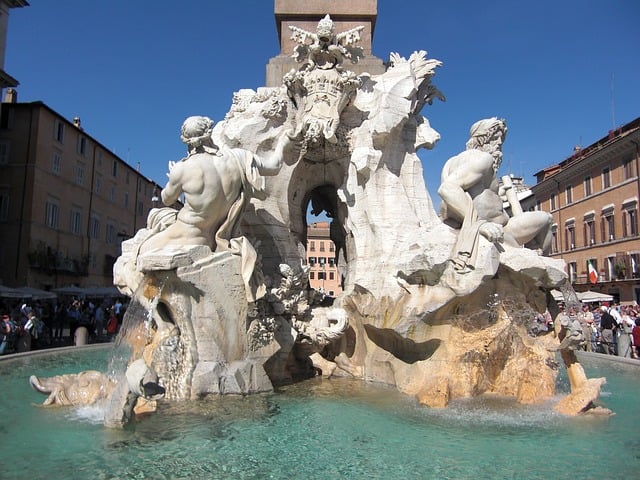
Commissioned by Pope Innocent X and designed by Bernini in 1651, the centerpiece is a tall Roman obelisk surrounded by four figures representing the following rivers: The Ganges, the Danube, the Rio de la Plata, and the Nile.
On the base of the fountain, you will find a dove, an olive branch, and the pope’s coat of arms.
Fontana del Moro
Located at the Southern end of Piazza Navona, this fountain (Fountain of the Moor) represents a Moor standing in a conch shell and wrestling with a dolphin while four Tritons surround him.

Although it was originally designed by Giacomo della Porta in 1575, Bernini would add the Moor which gave the fountain its name in 1653.
Fontana di Nettuno
Although it was once known as Fontana dei Calderi due to its original location, the fountain at the Northern end of Piazza Navona would eventually be updated to include a sculpture of Neptune fighting with an octopus.
As a result of this alteration, it was renamed the Fountain of Neptune.
Although the statue of its namesake was not built at the time, the fountain itself is still an excellent example of 16th-century architecture.
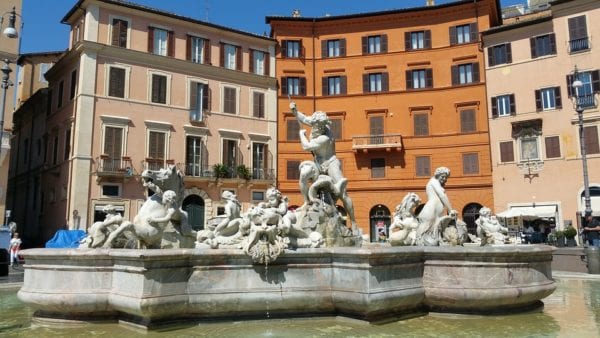
Church of Sant’Agnese in Agone
Found at the western end of Piazza Navona, the original church that was found here is thought to date back to 300 AD.
You’ll find this location right next to La Fontana dei Quattro Fiumi.

As with most churches in Rome, the Church of Sant’Angese features a very opulent design.
It was actually commissioned by the pope around the same time as the Fountain of Four Rivers, with famed architect Francesco Borromini involved in its designs.
Stadio di Domiziano
Otherwise known as the Domitian Stadium, this location is actually the first and only example of a masonry stadium in Rome.
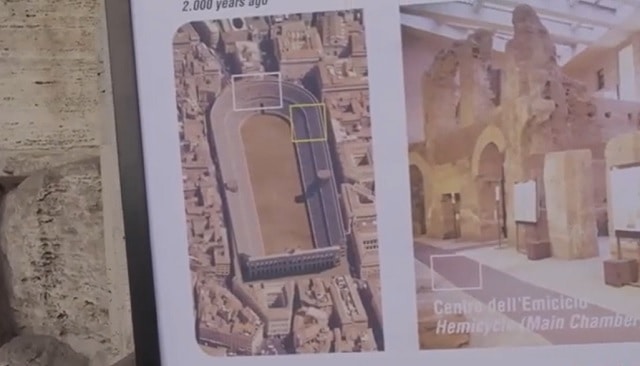
You can still visit the archaeological remains of this landmark to this day, and tours are available for those who want to learn more about the historic site.
Palazzo Torres
Originally built in the 16th century, this palace can be found south of Piazza Navona.
This is an excellent example of the type of architecture that was prevalent during the era, with travertine windows and a portal flanked by columns.
Some of the statues that were once located in the loggias have since been moved to the Vatican Museums, where you can still see them to this day.
Palazzo Braschi
This neoclassical palace is located at the Southern end of Piazza Navona, and it dates back to the 18th century.
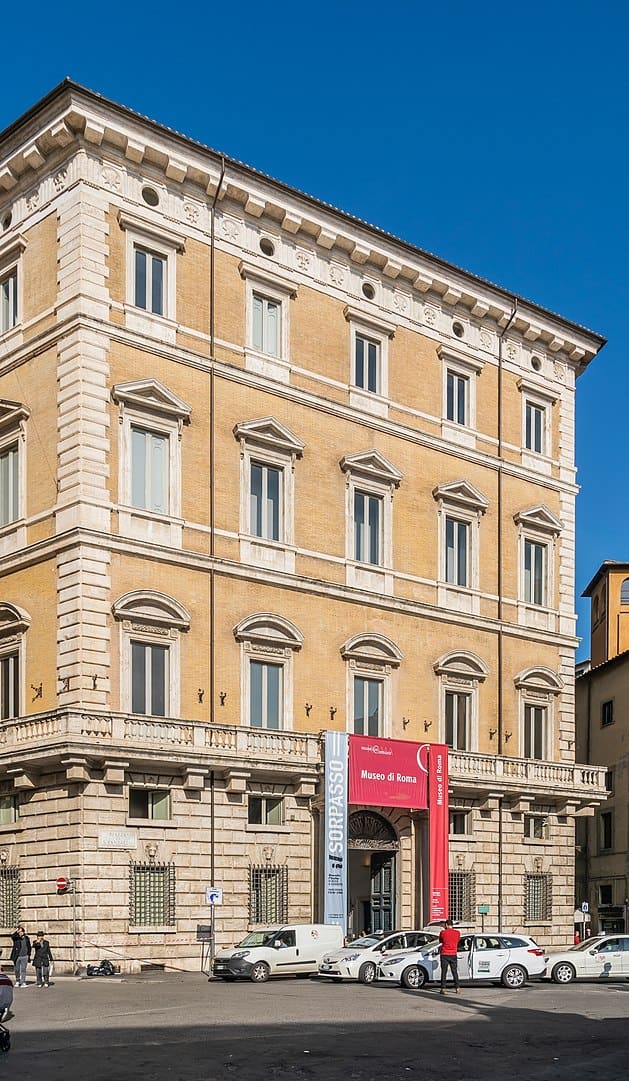
Although its use has changed over the years, today it houses the Museo di Roma – a museum that covers the history of Rome from the middle ages through the 19th century.
Admission to this museum is included for free with both the Roma Pass and the Omnia Vatican & Rome Card.
Plan Your Visit
The following section will provide details about planning a trip to Piazza Navona.
We will include information such as the best times to visit, how to find the plaza, and what you can do while you’re in the area.
Best Times to Visit
Since this is a public plaza, you are welcome to visit pretty much any time you want.
That being said, there are times when this location can become a lot more crowded and less comfortable.
Several visitors recommend coming to Piazza Navona when there are likely to be fewer people in the area,
But, you might also want to experience what the plaza is like when it gets a little busy.
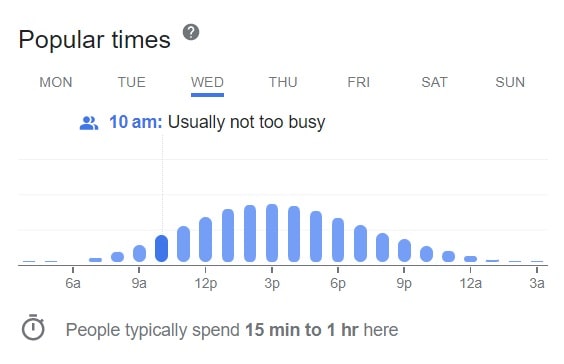
According to some visitors, there are two times you may want to consider either the morning or the evening.
Many people say the morning is the best time to see this historic location, noting that the crowds have yet to form and you’ll have plenty of room to get a good look at everything.
If this sounds good, consider arriving between the hours of 7 am - 10 am.
Alternatively, other reviewers suggest coming in the late afternoon at twilight/sunset in order to get the best views of sites such as the three fountains.
This is one of the most popular times to visit Piazza Navona, so you can expect larger crowds than usual, but some people feel like that’s just part of the charm.
If this sounds good, make sure to come between 5 pm - 8 pm.
And if you come during the month of December, much of Piazza Navona is transformed into a Christmas market.
How to Get Here
The best way to get here (and the method most people will use) is simply to walk.
There are a few metro/bus stops nearby, but no matter which method you choose, you’ll have to do a bit of walking to get here.
Use this Google Map for specific directions to Piazza Navona from anywhere in Rome.
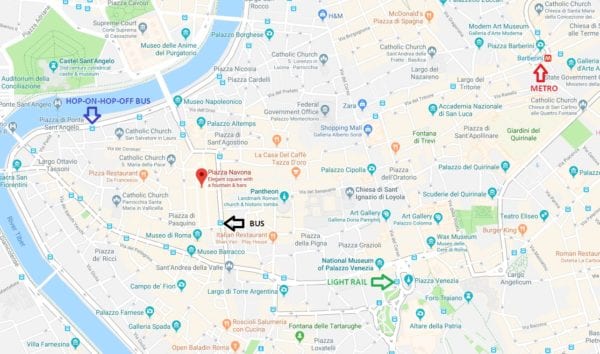
Hop-on-Hop-off Bus:
This is a good way to get to Piazza Navona if you are considering purchasing a hop-on-hop-off bus ticket.
The Vatican & Rome Open Bus tour actually provides a stop just one block from the plaza.

Other hop-on-hop-off bus tour companies have a stop at Castel Sant’Angelo, which is only 5-10 minutes away.
Metro:
There really aren’t any subway stops very close by. The closest stop is at Piazza Barberini, which is roughly 15-20 minutes away.
If you want to get closer, you can take the light rail to Piazza Venezia, which is about 10-15 minutes from Piazza Navona.
Alternatively, there is a bus stop at the Southeastern end of the plaza which is easily accessible and serviced by 11 different lines.
Read our post on how to use the Rome Metro system.
What to Expect
If you choose to visit Piazza Navona later in the morning or at some point throughout the rest of the day, you can expect a pretty big crowd.
At times, it may even get so crowded that you’ll want to keep an eye on your belongings to make sure that nobody takes them.
Many people come to this plaza to see some of the famous landmarks and sites in the area, but others come to shop or grab a bite to eat.
There are several stores and restaurants surrounding Piazza Navona, so you may want to consider taking a rest while you’re here.
In addition to shopping and getting some food, you’ll also find various street artists busking in the plaza.
While some may be performing music, others will do portraits of passers-by for money. If you’re so inclined, this could be an interesting and memorable experience.
For more information on things to do at Piazza Navona, check our what to see section.
Tour Options
There are a lot of guided outings that feature Piazza Navona.
Thanks to its location, many of the city centre tours will include a stop at this location, providing interesting details about some of the more significant sites in the area and continuing on to other popular landmarks like the Pantheon and Trevi Fountain.
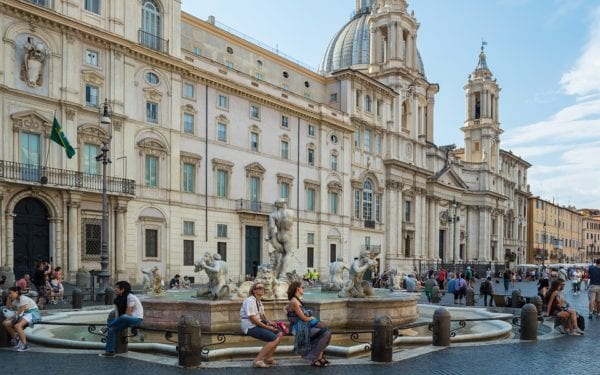
Alternatively, you can also take a self-guided city centre tour which includes Piazza Navona as a major stop.
In addition to that option, there is also a self-guided exploration game that tasks you with solving a mystery.
This outing is focused primarily on the Vatican, but it does include a stop at Piazza Navona.
No matter which option you choose, you can find more information about these services in our post about Rome city centre tours.
Nearby Attractions
In addition to the historic sites surrounding Piazza Navona, there are also a lot of notable landmarks nearby that you might want to visit.
This section will provide a list of locations that are within walking distance of this plaza.
The Pantheon
Located just a few blocks from Piazza Navona, this is one of the most popular historic sites in all of Rome.
For more details about this landmark, check our post about how to plan a visit the Pantheon.
Campo de’ Fiori
This is the location of Rome’s city market, and it’s one of the most popular places to do some shopping.
In addition to that, this is the location where they moved the city market after it was moved from its original location just a few blocks North at Piazza Navona.
This is also the starting point of our self-guided walking tour of Rome.
Castel Sant’Angelo
Roughly ten minutes from Piazza Navona, this is one of the most historic buildings in all of Rome.
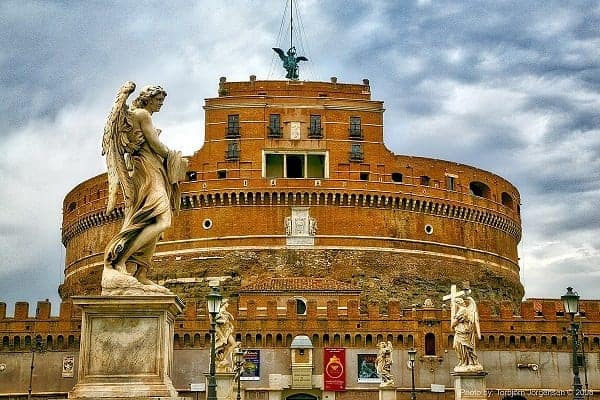
In addition to serving as a military installation, it has also been used as an escape route for the pope in case of danger.
There are a lot of interesting exhibits to see here, and you can learn more about them in our post about visiting Castel Sant’Angelo.
The Mausoleum of Augustus
Just a few blocks North of Piazza Navona, you will find this historic mausoleum that was built in 28 BC.
Although you can’t currently go inside and see the site up close, you are welcome to visit and take a look at the structure from the outside.
The Trevi Fountain
If you enjoyed seeing the incredibly detailed fountains at Piazza Navona, this historic site will blow you away.

This is one of the largest baroque fountains in all of Rome, and it is only 10-15 minutes East of the plaza.
For more details on visiting this famous location, make sure to read our post about planning a trip to the Trevi Fountain.
The Spanish Steps
Anyone headed to the Trevi Fountain may also want to consider walking about 10 minutes North of that site to the Spanish Steps.

This is one of the most popular meeting places in all of Rome, and it’s an absolute must-see during the spring when they line the steps with thousands of azaleas.
If you want to know more, read our post about visiting the Spanish Steps.








